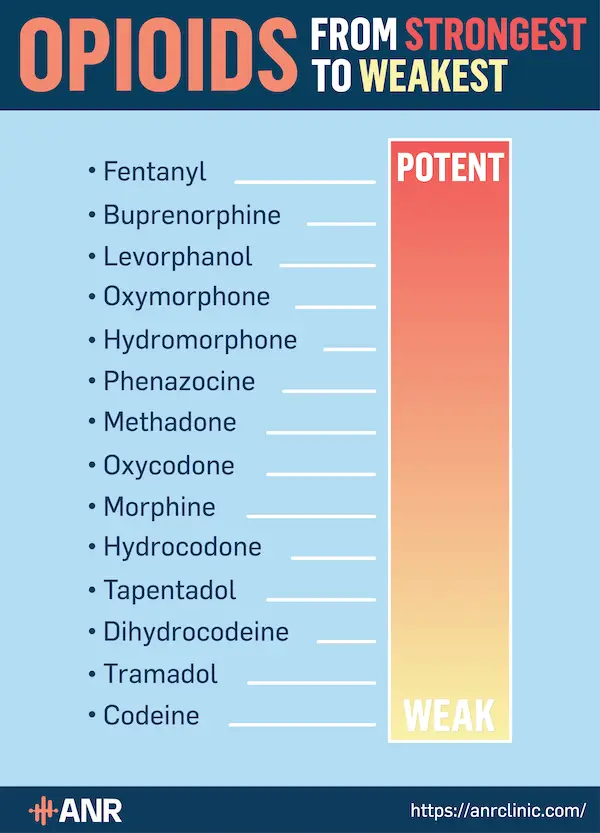Even though many opioids are prescribed a doctor, this does not always mean that a person is not at risk for developing a dependency. In fact, the potency of opioid drugs varies greatly, with fluctuations in their strength, and risk of addition. Some opioids are remarkably stronger than others, which in some cases can cause an overdose, if not taken as prescribed, while others are relatively mild. It is important to know where the opioids you are taking rank, to help make a better-informed decision as to whether the benefits will outweigh the risks.
14 Common Opioid Drugs from Strongest to Weakest
- Fentanyl– Fentanyl is a synthetic opioid that is regarded as one of the most dangerous drugs. Typically prescribed for severe pain following a surgery, fentanyl has gained popularity on the streets as a substitute for, or often mixed in with heroin. It is said that fentanyl can be up to 50 times more powerful than heroin, which is an already notoriously powerful opioid. Fentanyl is highly addictive, extremely potent, and therefore the most dangerous opioid drug on our list.
- Buprenorphine – Surprisingly, the opioid Buprenorphine, which is typically prescribed as an opioid replacement medication, designed to relieve opioid withdrawal symptoms, is a highly dangerous and addictive drug. It is nearly 25-50 times stronger than morphine, and therefore has the potential for an overdose, especially if taken by someone who is opioid naive. A small dose of this drug is very powerful, and due to the fact, it is a long-acting opioid, is very addictive and much harder to detox from than typical opioid drugs.
- Levorphanol – Levorphanol is a synthetic opioid painkiller designed to treat moderate to severe pain. Levorphanol is much more potent than morphine and is highly addictive. Levorphanol has the ability to cause serious or potentially life-threatening breathing problems, especially during the first 24 to 72 hours of consumption and any time the dose is increased.
- Oxymorphone – Oxymorphone, which is sold under the brand name Opana ®, has medicinal use for treating moderate to severe pain. Despite having a legitimate medical purpose, Oxymorphone still has high potential for abuse. Typically, Oxymorphone is prescribed in pill form, however it also comes as a liquid made for injection.
- Hydromorphone – Hydromorphone, or which is also known as Dilaudid ®, is a pain medication prescribed to treat severe pain. This drug is much stronger than morphine and produces strong sedation effects. It can be injected causing effects similar to heroin and is a common substitute for heroin.
- Pentazocine – Pentazocine, which is sold under the brand name Talwin ® among others, is a painkiller prescribed before or after surgery, for moderate to severe pain. This opioid is unique in the sense that sometimes it is combined in an oral formulation with Naloxone, to prevent abuse such as attempting to inject the drug. Despite these preventative measures, Pentazocine still has great potential for abuse, addiction, and overdose.
- Methadone – Methadone is a prescription opioid that is used in the treatment of opioid addiction as a substitute therapy, designed to help the addict feel relief from withdrawal symptoms. Even though Methadone is prescribed in order to wean people off of opioids, it still has great potential for abuse. Due to the fact that it is a long-acting opioid, Methadone is highly addictive and can be much more difficult to stop using than typical short-acting opioids.
- Oxycodone – Oxycodone is one of the most popular opioids today, sold under many names and formulations such as Percocet ®, Roxicodone ®, and more. Despite being one of the most prescribed opioids, it still has great potential for abuse and addiction. It has a strong sedation effect that may lead to respiratory depression and overdose. Oxycodone is also commonly injected, snorted, and abused by addicts, making this a very dangerous opioid.
- Morphine – Morphine is an opiate naturally derived from the poppy plant, prescribed for treating pain. Even though it is not a synthetic opioid, it is still very potent, and carries great risks. It is most commonly prescribed as a tablet, or injection. Many users prefer to inject this drug since it will produce instantaneous effects. Morphine has high potential for addiction, although not as strong as its synthetic counterparts it can lead to dependency.
- Hydrocodone – Hydrocodone is an opioid combined with acetaminophen, prescribed for patients with chronic pain or injuries. It has a similar strength to morphine and carries similar risks. Hydrocodone is sold under many brand names, including Vicodin ®, and Norco®. Hydrocodone is one of the most commonly prescribed opioids and can pose significant risks to one’s health. Despite being considered relatively weak, hydrocodone has high potential for abuse and dependency, as well as overdose.
- Tapentadol – tapentadol is a less commonly abused opioid, yet still carries high risk for addiction and dependence. Typically prescribed for both acute and chronic musculoskeletal pain, tapentadol may be habit forming with prolonged use. This drug has the potential to cause respiratory distress, especially when combined with alcohol such as other substances.
- Dihydrocodeine – dihydrocodeine is a semi-synthetic opioid analgesic prescribed for pain. It also has other uses such as treating fever and swelling, since it is combined with pain relievers, aspirin, and caffeine. The aspirin decreases the fever, and swelling, and the caffeine is to increase the effectiveness of this combination. Serious side effects are uncommon after taking Dihydrocodeine, but it still has potential for abuse. While it is not considered to be as dangerous as other opioids, it carries the risk of overdose, especially when combined with other drugs such as heroin or methadone.
- Tramadol – Tramadol, sometimes sold under the brand name Ultram®, is typically regarded as a less dangerous opioid since there is a lower risk of abuse, addiction, and developing tolerance. Even though it is a weaker opioid, it still has potential for abuse and can lead to dependency. Tramadol is approximately 1/10 the strength of morphine, but has the potential to cause an overdose or dependency after long term use.
- Codeine– codeine is most commonly found as a prescription cough syrup, to reduce coughing in patients. It can also be prescribed for mild to moderate pain, in a tablet that also contains acetaminophen. Although this drug is relatively weak, it can be abused, and can lead to the typical opioid side effects. Many patients regard codeine as simply a cough syrup, not realizing it is actually an opioid.

Additional Information
How Long Does Dilaudid Stay in Your System?



